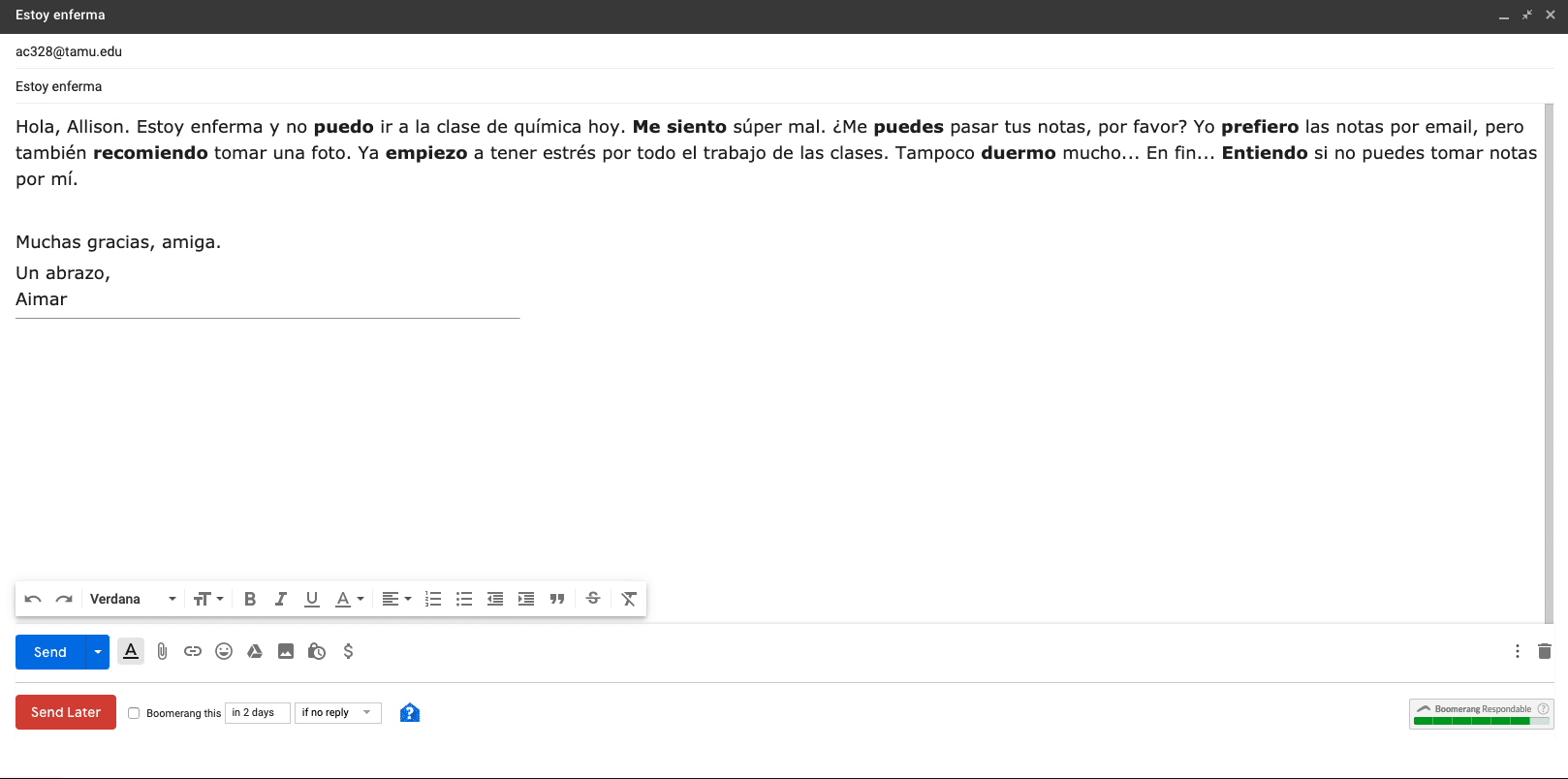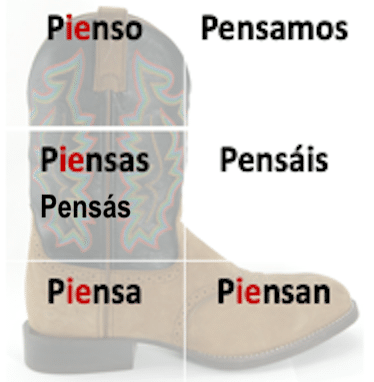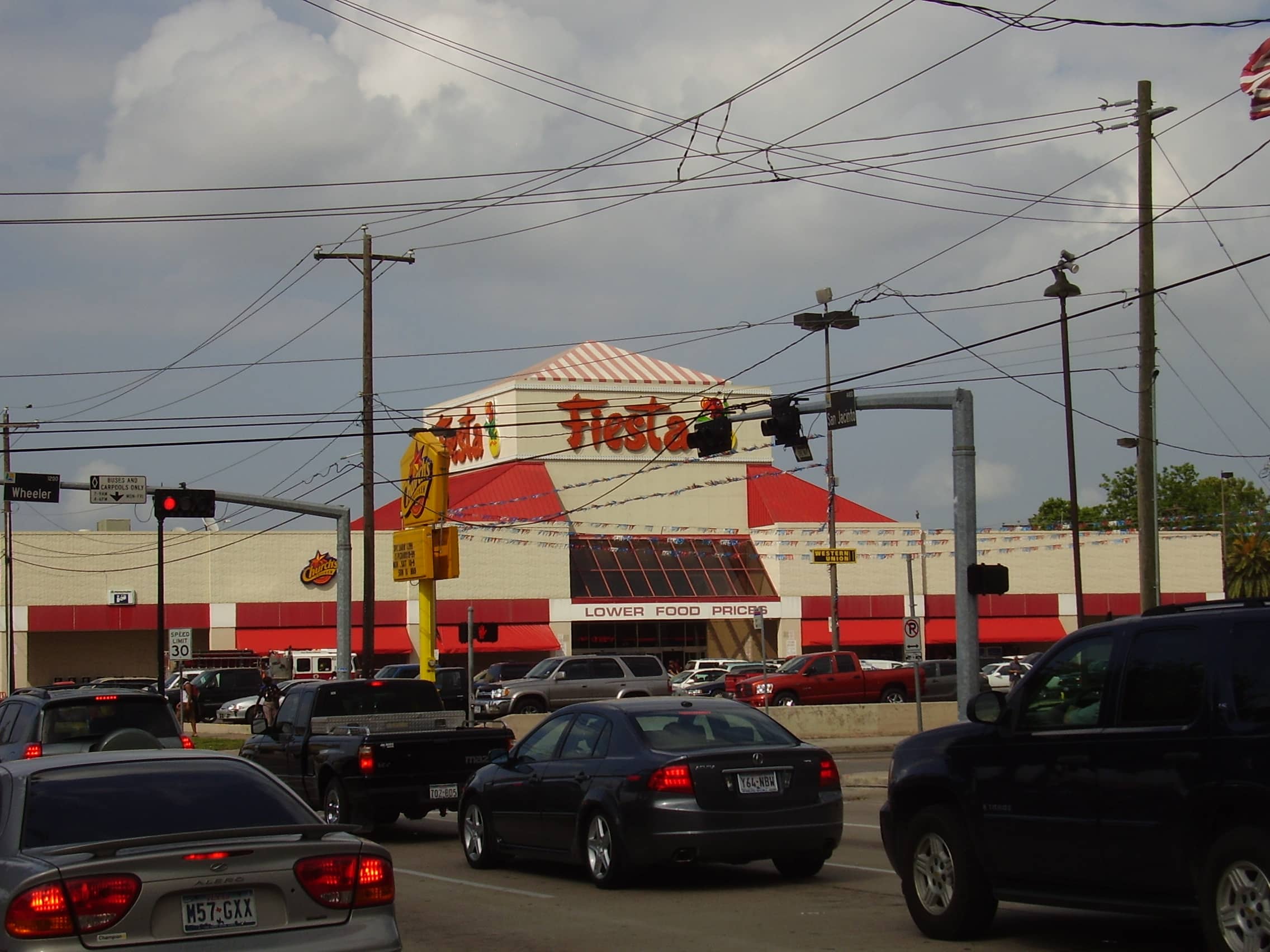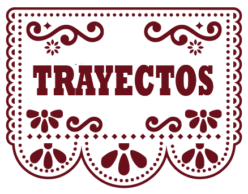The present tense of stem-changing verbs (e→ie; o→ue; u→ue; e→i): Uso y forma
El e-mail de Aimar
Ahora vamos a leer un email de Aimar a Allison, su amiga y compañera en la clase de química. ¿Qué problema tiene Aimar? Pay attention to the verbs she uses. Remember the verb querer in Introducción comunicativa? The verbs in the email behave in the same way. What do you think their infinitive forms are? What do they mean?

¿Comprendiste? Completa estas oraciones con la información del email de Aimar.
- Let’s talk about verbs in the conversation first.
- Escribe the infinitive forms of the verbs in bold:
- Based on the infinitives, hypothesize about the changes that take place when these verbs are conjugated:
- Mira el verbo me siento. ¿Cómo se llaman estos verbos? Hint: We learned about this type of verbs in Module 1
- Ahora hablamos del contenido del email (continue paying attention to the verb forms):
- Aimar no puede ir a clase porque…
- Aimar pide las ______________ de clase a Allison y recomienda una ______________ también.
- Aimar empieza a tener ______________ porque ella tiene mucho ______________ en sus clases.
- Aimar tiene otro problema. Ella dice: “No ______________ mucho”.
These verbs are what we call stem-changers, which means that, when the infinitive is conjugated, some of the verb’s vowels change. In the next section, you will learn about what stem-changing verbs are and how we conjugate them.
I. Conjugación
As you know, all Spanish verbs have a stem (la raíz) and an ending (-ar / -er / -ir)
pensar: stem = PENS; ending = AR volver stem = VOLV; ending = ER pedir: stem = PED; ending = IR
These verbs belong to a large group of verbs that change their stem in the present tense and fall into one of these three different types of changes in their stem:
e → ie;
o/u → ue;
e → i
It is important to note that not all stem-changing verbs change for all subjects. To help you remember where the changes take place, we have a trick! Think of the verbs as being in the shape of a boot (see illustration below). The only forms that change are those inside the boot. Let’s have a look at pensar (to think):

Yes, in these verbs, the stem will change in all conjugations, except for vos (informal you, Argentina and Uruguay), nosotros and vosotros.
Modified from: “Stem Changing Verbs” by Enrique Yepes, licensed under CC BY 4.0.
II. Verbos
Stem-changing Verbs: e → ie
| comenzar | to start |
| empezar | to begin |
| entender | to understand |
| hervir | to boil |
| pensar | to think |
| preferir | to prefer |
| querer | to want |
| recomendar | to recommend |
| sentirse | to feel in a certain way or to be suffering from the symptoms of a certain state (e.g., Me siento cansada—I feel tired) |
Based on the rules discussed, conjugate the verb entender. Write the forms next to the person.
| yo | nosotros |
| tú
vos |
vosotros |
| él/ella/usted | ellos/as /ustedes |
Stem-changing Verbs: o/u → ue
| almorzar | to have lunch |
| acostarse | to go to bed |
| costar | to cost |
| dormir | to sleep |
| dormirse | to fall asleep |
| encontrar | to find |
| jugar | to play a game or sport |
| mostrar | to show |
| poder | to be able to |
| probar | to taste/ to try on |
| volver | to come back/return |
Based on the rules discussed, conjugate the verb poder. Write the forms next to the person.
| yo | nosotros |
| tú
vos |
vosotros |
| él/ella/usted | ellos/as /ustedes |
Stem-changing Verbs: e → i
| desvestirse | to undress (oneself) |
| pedir | to ask for/to request |
| seguir | to follow/to continue |
| servir | to serve |
| vestirse | to dress (oneself) |
Based on the rules discussed, conjugate the verb vestirse. This is a reflexive verb, so you will need to use the reflexive pronouns. We have done the first one for you. Write the forms next to the person.
| yo me visto | nosotros |
| tú
vos |
vosotros |
| él/ella/usted | ellos/as /ustedes |
![]() ¡Ojo!
¡Ojo!
In Spanish, the verb poder is used in the same way as the modal can in English, to express you have the ability to do something, or, due to specific circumstances, you are able to do something. Like can, it is followed by a verb in the infinitive. Have a look at these examples from Aimar’s email.
Estoy enferma y no puedo ir a la clase de química hoy. ¿Me puedes pasar tus notas?
Piensa en tu español hasta ahora. ¿Qué puedes hacer? Responde esta pregunta con 3 oraciones con los verbos entender, hablar y leer para describir what you can do with Spanish so far.
(Yo) puedo escribir un párrafo sobre mi rutina.
Now that you have learned what stem-changing verbs are and how they are conjugated, we recommend that you watch the following video, which summarizes the information presented in this section.
![]() Stem Changing Verbs
Stem Changing Verbs
Attribution: El presente. By srtakendrick, CC BY.
Now it’s time to use our new structures: Visita la página en https://bit.ly/VerbIrreg y completa las actividades 1, 2 y 3 para practicar más. Actividad 2-10. El blog de Aimar. Paso 1. En su blog, Aimar escribe sobre sus experiencias como estudiante en Texas. ¿De qué tema en particular va a hablar Aimar? Mira la foto y lee su blog. Completa los espacios en blanco con la conjugación de los verbos en paréntesis. Vamos a usar los verbos that we just saw and others! ¡Hola, Gente! Hoy voy a escribir sobre uno de mis lugares favoritos en Houston, el supermercado Fiesta. Cuando yo (1) ___________________ (pensar) en este Mercado, siempre (2) ___________________ (sonreír). Esta foto (3) ___________________ (mostrar) el local en la calle San Jacinto, donde siempre (4) ___________________ (hacer) mis compras y (5) ___________________ (almorzar) con mis amigas latinas. Ellas y yo siempre (6) ___________________ (preferir) ir a Fiesta porque allí (7) ___________________ (poder) encontrar los ingredientes para preparar la comida tradicional de nuestras culturas y además todo (8) ___________________ (costar) menos que en otros supermercados. Los mercados Fiesta (9) ___________________ (tener) una historia muy interesante. Los primeros locales (10) ___________________ (comenzar) en 1972 (mil novecientos setenta y dos), precisamente en Houston y, en los años siguientes, los dueños (owners) (11) ___________________ (seguir) abriendo otros locales en otras ciudades como Austin y Dallas. En la actualidad, si tú (12) ___________________ (querer), (13) ___________________ (poder) hacer tus compras en uno de los 50 mercados Fiesta en estas ciudades. También, el mercado (14) ___________________ (servir) comida de todo tipo. Yo siempre (15) ___________________ (pedir) las fajitas vegetarianas. ¡Deliciosas! Si tú (16) ___________________ (probar) las fajitas, te van a fascinar. Sí, sin duda, yo (17) ___________________ (recomendar) las fajitas y el mercado en general. En Fiesta, tu billetera (wallet) siempre (18) ___________________ (sentirse) muy bien. Information from original text by Wikipedia, licensed under CC BY-SA 3.0. Ahora trabaja con un@ compañer@. Visita el sitio de Fiesta en español (https://bit.ly/SupFiesta) y busca la siguiente información. Ahora trabaja con cuatro compañer@s. Van a escribir un blog (como el blog de Aimar) sobre su mercado o supermercado favorito. Primero van a decidir sobre qué supermercado/mercado escriben. Esta información debe estar en su blog: 1. Nombre y lugar donde está el mercado/supermercado 2. Símbolo de la marca 3. Cómo es y por qué prefieren comprar allí 4. Los departamentos que hay 5. La historia 6. Qué recomiendan Deben incluir fotografías y enlaces (links). Remember to use open resources. You can find them using the Creative Commons search page: https://search.creativecommons.org/. Don’t forget to cite your sources!![]() ¡Manos a la obra!
¡Manos a la obra!![]() Actividad 2-9. Practicamos un poquito.
Actividad 2-9. Practicamos un poquito.

![]() Paso 2. Más sobre el mercado Fiesta.
Paso 2. Más sobre el mercado Fiesta.
Símbolo de la tienda
Colores de la marca
¿Cuántos departamentos hay en el mercado? ¿Qué vende cada uno?
¿Qué comidas sirve la rotisería (deli)?
¿Qué puede hacer la gente en Fiesta además de comprar ingredientes o comer?
¿Qué tipo de recetas ofrece?
![]() Paso 3. Nuestro mercado favorito.
Paso 3. Nuestro mercado favorito.
Click on the following button to continue using your new structures.
Ahora dejamos la comida y hablamos sobre la ropa y la moda. Vamos a


